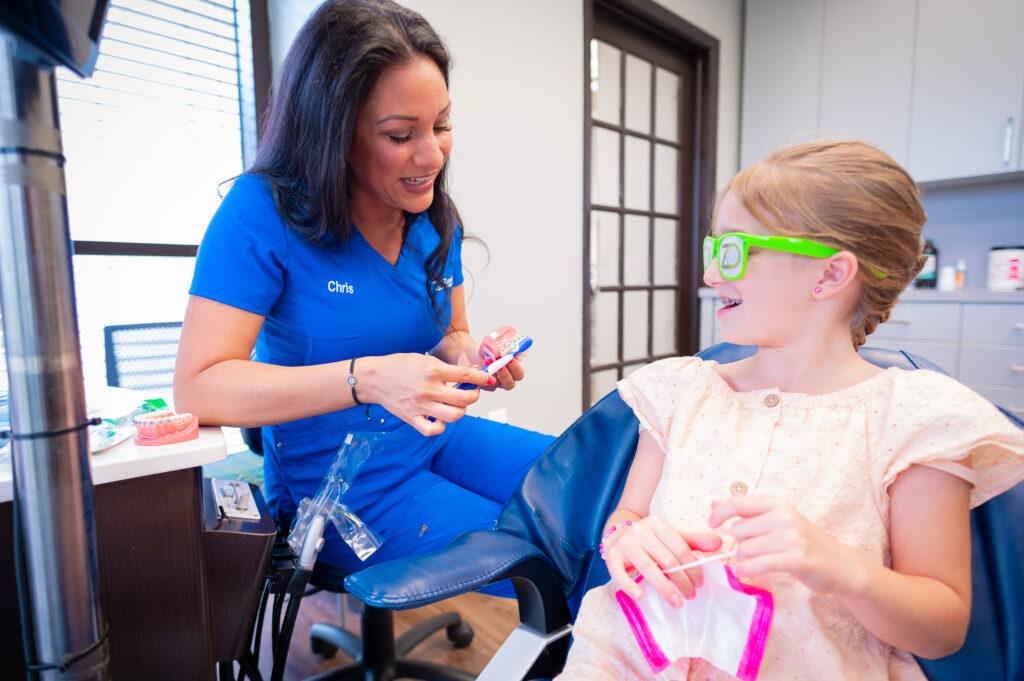Whiter teeth are good, but white spots on teeth aren’t. Some patients find white spots on some teeth after braces. Those spots are called decalcification, and they are preventable.
White marks on teeth with braces usually form around the brackets, but they can occur anywhere on the tooth with or without braces. Good oral hygiene habits are the best way to avoid these white spots.
Zombek Orthodontics wants you to have a successful treatment with a beautiful smile at the end. The best way to ensure this is by brushing and flossing daily and thoroughly throughout your treatment to avoid white spot lesions from forming.
Are white spots on teeth from braces? The answer is no; they aren’t from the braces themselves. However, braces may contribute to why people have white spots on their teeth after braces. That’s because braces can make brushing and flossing your teeth more difficult.
The white spots are called decalcification. It’s the demineralization of calcium in your tooth’s enamel. This causes a thinning of the enamel. Eventually, the thin spots could fall victim to tooth decay and become cavities.
Dental decalcification occurs when bacteria and plaque pull minerals from the enamel. The easiest way to fight this is to brush your teeth regularly and properly. That’s easy to do with nothing on your teeth, but it may be a bit harder with brackets and wires in the way. However, there are tools that make it easier to clean your teeth well.

Teeth decalcification affects the enamel, the hard outer shell of your tooth responsible for protecting the living interior. One of the main components of enamel is calcium. This mineral is targeted by bacteria and acids that make up plaque.
The bacteria and acids leech calcium from the enamel, causing that area of the enamel to thin and turn white. Tooth decalcification is often seen on the front teeth but can also appear on the back teeth.
Certain foods can leave acids and bacteria on your teeth and accelerate the formation of braces white spots. Sugary or acidic foods do this more than others. This includes sodas, citrus fruits, candy, fruit juices, and some sports drinks.
White spots can also form because of certain medical conditions, including chronic dry mouth, poor nutrition, and hypoplasia (enamel thinning). Some of these conditions may be the result of side effects from certain medications. You can speak with your doctor about alternate medications. You can also talk with your dentists about ways to combat chronic dry mouth.
Poor oral hygiene is the main cause of dental decalcification. To avoid white spots, you need to brush your teeth at least twice a day for two minutes and floss at least once a day. Good oral hygiene must be practiced with or without braces.
It isn’t always easy to brush and floss with braces, but it’s necessary to prevent white marks on teeth after braces. Here are some top tips to prevent enamel decalcification and poor dental hygiene.

What do you do if you do have white spots after braces? Unfortunately, decalcification on teeth is permanent. There are ways to reduce the appearance of white spots and strengthen your enamel.
Tooth whitening can lighten the tooth color and make the white spots less noticeable. It’s best to have this done professionally to get the best results. However, tooth whitening isn’t permanent. You will need to return for treatments in the future.
You can also treat white spots with microabrasion, which removes a thin layer of enamel to even out the color of your tooth. This can lead to tooth sensitivity, so discussing this option with your dentist is best. You can also discuss dental veneers, thin shells placed on the front of the teeth to give them a flawless appearance.
A fluoride treatment can strengthen your enamel and reduce the chances of developing white spots. Check with your dentist to see if they provide fluoride treatments.
At Zombek Orthodontics, we aim to give you the smile of your dreams. We will do all we can to encourage you on your journey while providing top-notch orthodontic treatment. However, successful braces treatment also depends on you.
The last thing we want to see is white spots on your teeth after braces. The best way to avoid this while wearing braces is to brush and floss your teeth every day. Brushing twice a day and flossing once a day will keep damaging plaque and acid buildup off your teeth. This will prevent decalcification and help you achieve your best smile.

 This site’s strategy, design, photo & video were created by the marginally-above-average folks @ Clear Partnering Group.
This site’s strategy, design, photo & video were created by the marginally-above-average folks @ Clear Partnering Group.